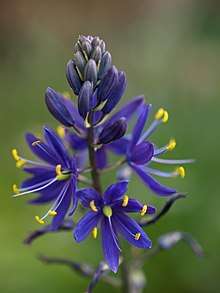Camassia leichtlinii
Camassia leichtlinii, commonly known as great camas or large camas, is a perennial herb. It is native to western North America in British Columbia in Canada and the United States, in California, Nevada, Oregon and Washington.[2]
| Camassia leichtlinii | |
|---|---|
 | |
| Great camas inflorescence | |
| Scientific classification | |
| Kingdom: | Plantae |
| Clade: | Tracheophytes |
| Clade: | Angiosperms |
| Clade: | Monocots |
| Order: | Asparagales |
| Family: | Asparagaceae |
| Subfamily: | Agavoideae |
| Genus: | Camassia |
| Species: | C. leichtlinii |
| Binomial name | |
| Camassia leichtlinii | |
| Synonyms | |
|
Camassia esculenta var. leichtlinii Baker | |
Description
Great camas is a perennial herb that grows from an edible bulb. It can grow 24–48 inches (61–122 cm) tall. Leaves are long and narrow, stemming from the basal rosette. The inflorescence is a spike-like cluster on a leafless stem that is held above the leaves.[3] It can be mistaken for the more common Camassia quamash, which has an overlapping range.
Ecology
It needs consistent moisture in the spring, but will not be harmed by seasonal drought after the seed pods mature and the leaves dry out.[3] Camas stands can benefit from seasonal fires as well, as they aid in regeneration and reduce competition from brush and weeds.[3]
References
- "Camassia leichtlinii". NatureServe Explorer. NatureServe. Retrieved 2018-04-07.
- "Comprehensive Report Species -". explorer.natureserve.org. Retrieved 2018-04-11.
- "Great Camas" (PDF). December 5, 2000. Retrieved April 10, 2018.
